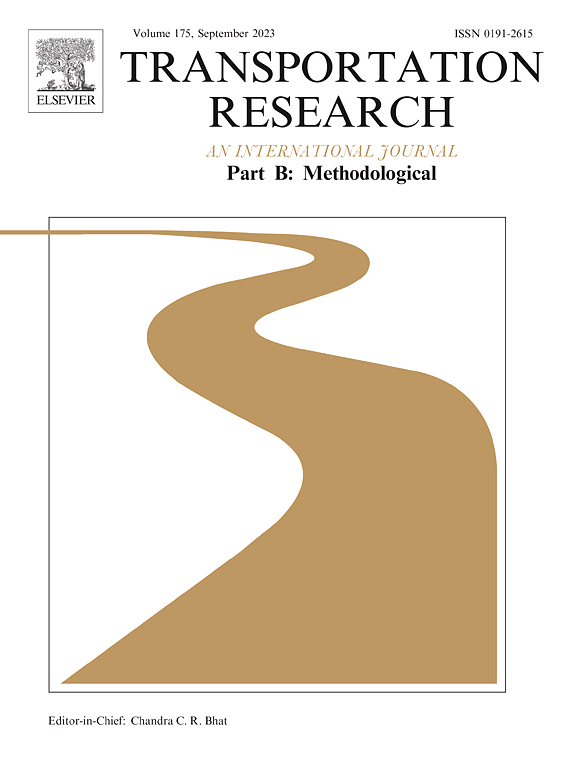Adaptive signal control at partially connected intersections: A stochastic optimization model for uncertain vehicle arrival rates
IF 6.3
1区 工程技术
Q1 ECONOMICS
引用次数: 0
Abstract
Optimizing traffic signal control is crucial for improving efficiency in congested urban environments. Current adaptive signal control systems predominantly rely on on-road detectors, which entail significant capital and maintenance costs, thereby hindering widespread implementation. In this paper, a novel connected vehicle (CV)-based adaptive signal control (CVASC) framework is proposed that optimizes signal plans on a cycle-by-cycle basis without the need for on-road detectors, leveraging partial CV data. The framework comprises a consequential system delay (CSD) model, deterministic penetration rate control (DPRC), and stochastic penetration rate control (SPRC). The CSD model analytically estimates vehicle arrival rates and, consequently, the total junction delay, utilizing CV penetration rates as essential inputs. Employing the CSD model without considering CV penetration rate uncertainty results in fixed vehicle arrival rates and leads to DPRC. On the other hand, incorporating CV penetration rate uncertainty accounts for uncertain vehicle arrival rates, establishing SPRC, which poses a high-dimensional, non-convex, and stochastic optimization problem. An analytical stochastic delay model using generalized polynomial chaos expansion is proposed to efficiently and accurately estimate the mean, variance, and their gradients for the CSD model within SPRC. To solve DPRC and SPRC, a gradient-guided golden section search algorithm is introduced. Comprehensive numerical experiments and VISSIM simulations demonstrate the effectiveness of the CVASC framework, emphasizing the importance of accounting for CV penetration rate uncertainty and uncertain vehicle arrival rates in achieving optimal solutions for adaptive signal optimizations.
部分连通交叉口的自适应信号控制:不确定车辆到达率的随机优化模型
在拥挤的城市环境中,优化交通信号控制对于提高交通效率至关重要。目前的自适应信号控制系统主要依赖于道路探测器,这需要大量的资金和维护成本,从而阻碍了广泛实施。本文提出了一种新的基于车联网(CV)的自适应信号控制(CVASC)框架,该框架利用部分CV数据,在不需要道路探测器的情况下,逐周期优化信号计划。该框架包括相应系统延迟(CSD)模型、确定性渗透率控制(DPRC)和随机渗透率控制(SPRC)。CSD模型分析估计车辆到达率,因此,总路口延迟,利用CV渗透率作为基本输入。采用不考虑CV渗透率不确定性的CSD模型,导致车辆到达率固定,并导致DPRC。另一方面,将CV渗透率的不确定性考虑到车辆到达率的不确定性,建立了一个高维、非凸、随机优化问题。为了有效准确地估计SPRC内CSD模型的均值、方差及其梯度,提出了一种利用广义多项式混沌展开的解析随机延迟模型。针对DPRC和SPRC问题,提出了一种梯度引导的黄金分割搜索算法。综合数值实验和VISSIM仿真证明了CVASC框架的有效性,强调了考虑CV渗透率不确定性和车辆到达率不确定性在自适应信号优化中获得最优解的重要性。
本文章由计算机程序翻译,如有差异,请以英文原文为准。
求助全文
约1分钟内获得全文
求助全文
来源期刊
CiteScore
12.40
自引率
8.80%
发文量
143
审稿时长
14.1 weeks
期刊介绍:
Transportation Research: Part B publishes papers on all methodological aspects of the subject, particularly those that require mathematical analysis. The general theme of the journal is the development and solution of problems that are adequately motivated to deal with important aspects of the design and/or analysis of transportation systems. Areas covered include: traffic flow; design and analysis of transportation networks; control and scheduling; optimization; queuing theory; logistics; supply chains; development and application of statistical, econometric and mathematical models to address transportation problems; cost models; pricing and/or investment; traveler or shipper behavior; cost-benefit methodologies.

 求助内容:
求助内容: 应助结果提醒方式:
应助结果提醒方式:


